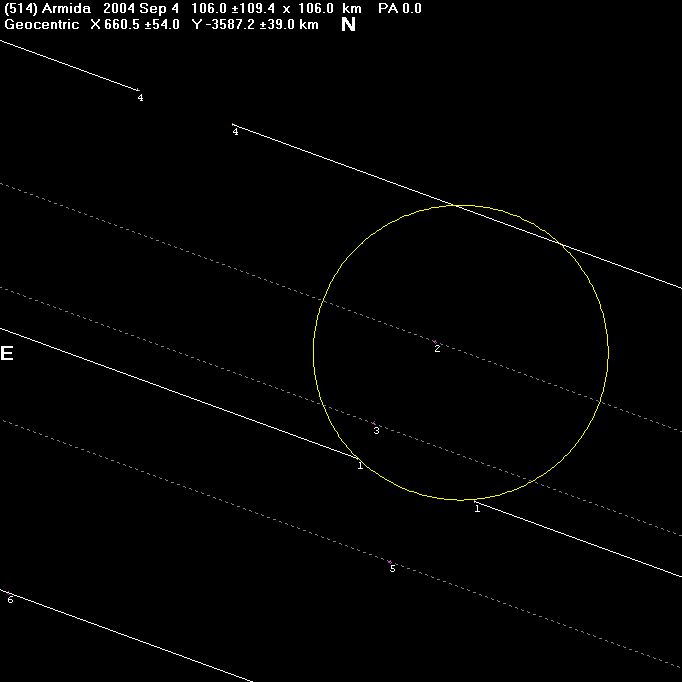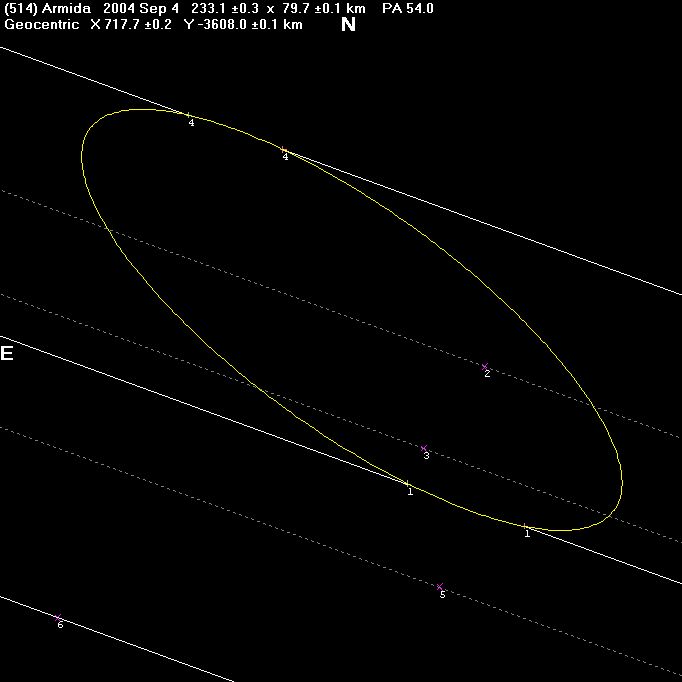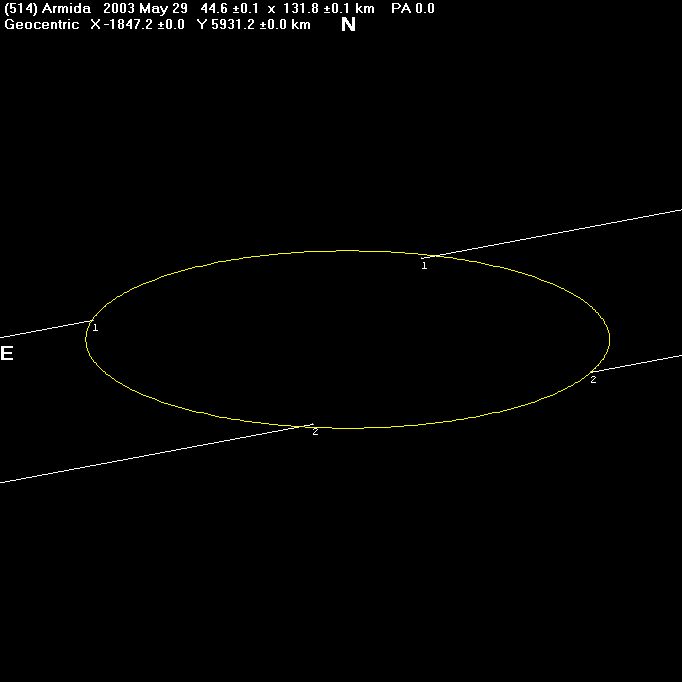Preamble:
The high certainty updated path for this event crossed the North Island of New Zealand with Gisborne and Wanganui towards the southern edge and New Plymouth on the northern side.
One definite visual occultation was obtained from Gisborne (2 observers). An occultation may also have been seen from Whakatane although with less certainty. Other observers within the occultation path near the west coast of the North Island were clouded out.
Observers: 1 J Burt/J Drummond, Gisborne, NZ 2(C) R Austin/S Suter, Eltham, NZ 3(C) R Skilton, Kohi, NZ 4 D Watson, Whakatane, NZ 5(C) R Wright, Wanganui, NZ 6(M) T Butt, Te Horo, NZ C = Cloud M = Miss
Discussion:
This event has yielded yet another tantalising (but very possibly significant) result.
The observation by John Burt and John Drummond in Gisborne was quite certain, with the two observers using piggy-backed telescopes. John Burt commented: "The reappearance was different in that the star slowly brightened after disappearing for 3.7". The star slowly brightened for 3.75" then snapped on...(witnessed by both John Drummond at the 8" and me at the 16").
An explanation for the very extended rebrightening of the star is likely to be that the observers were seeing the star appear at a very glancing angle to the edge of the asteroid. Extended reappearance times are sometimes observed at grazing occultations, where they are due to lengthening of the Fresnel diffraction fringes when the star's apparent motion is very close to the slope of the lunar limb in the region of the reappearance. This is the most likely effect here, and the fact that both observers, using large instruments, saw the extended rebrightening lends this explanation considerable credibility.
Diana Watson in Whakatane, near the northern limit of the predicted track, may also have seen an event. As the comments in her report below show, she initially did not report an occultation. However a day or two later she did report that the star had seemed to disappear for "3 or maximum 4 seconds", but she was unsure whether this was because she had moved her head. She did not make a definitive timing of the duration of this disappearance.
The first plot below shows the observations plotted against the 106 km expected diameter of Armida, with the Whakatane result assigned zero weight. Note that the Whakatane observation is significantly offset from the Gisborne times.

The following plot shows the situation if the Whakatane observation is included in the result. A very extended ellipse of roughly 233 x 80 km fits the data (bearing in mind that the duration of the Whakatane event is uncertain).

(Plots generated using WinOCCULT - Disappearances on the right; Reappearances on the left)
It is by no means out of the realms of possibility that this second plot is an approximation to the true shape of the asteroid. What gives some credence to this is the very extended reappearance observation of the Gisborne observers, which would tie in with the star reappearing at a glancing angle to the limb of the asteroid under this scenario.
Further evidence in support of this scenario comes from the one previously observed occultation by Armida. On May 29, 2003, two chords were observed across the asteroid, these chords also being significantly offset from each other. This data can be fit by an ellipse of about 132 x 45 km, whose semi-major/semi-minor axis ratio is approximately 2.9. It is interesting to note that in our case, a result of about 233 x 80 km also yields an axial ratio of 2.9.

Conclusions:
This is a very tantalising result, and it is a shame that other observers on the west coast were clouded out, and no other observers on the eastern North Island coastal regions contributed data. Nevertheless, the data obtained at this occultation (assuming Diana Watson did see an event) does tend to confirm that Armida has a substantially ellipsoidal shape. As such, it will make a most interesting target for future MP occultations.
Observational Data:
Observer's Names : John Burt, John Drummond
Aperture (cm) : 40cm f4.5 + 20 cm
Focal length (cm) : 180 cm + 200 cm
Type (e.g. SCT; Newtonian) : Newtonian + SCT
Magnification : 83 x's
Observing site name : Possum Observatory, Gisborne
Longitude (DD MM SS ; East +ve) : 178* 02' 33.84" E
Latitude (DD MM SS ; South -ve) : 38* 40' 03.72" S
Height above Sealevel (metres) : 12
Geodetic Datum (e.g.WGS84,NZ1949): WGS84
Height Datum (if known) : MSL
Sky Transparency (Delete two) : Fair
Star Image Stability (Delete two): Good
Time Source (e.g. WWVH, GPS) : DSIR phone clock
Recording method (e.g. tape) : tape recorder
Could you see the Asteroid? : no
Approx. Limiting Magnitude : 13.5
| Estimated |
Universal Time | Reaction | Accuracy, Remarks
h m s | Time (sec) |
Started Observing : 12 09 00
Disappearance At : 12 11 4.9"
Reappearance At : 12 11' 8.6"
(Slowly brightened for 3.75" and then came back on to full
brightness at 12h 11' 12.35")
Stopped Observing : 12 13 00
Was your reaction time (also known as Personal Equation) subtracted from
any of the above timings? : No
ADDITIONAL COMMENTS: The reappearance was different in that the star slowly brightened after
disappearing for 3.7". The star slowly brightened for 3.75" then snapped on...(witnessed by
both John Drummond at the 8" and me at the 16"). John D and I both saw this from the same
location (telescopes were piggybacked).
Observer's Name : Diana Watson
Aperture (cm) : 20
Focal length (cm) : 200
Type (e.g. SCT; Newtonian) : Celestron 8
Magnification : 115 times
Observing site name : Whakatane
Longitude (DD MM SS ; East +ve) : 176 51 50.7
Latitude (DD MM SS ; South -ve) : -37 55 18.5
Height above Sealevel (metres) : 2.8 metres
Geodetic Datum (e.g.WGS84,NZ1949): WGS84
Height Datum (if known) : MSL
Sky Transparency (Delete two) : Good
Star Image Stability (Delete two): Good
Other Conditions:
(Wind, Clouds, Lights, etc.): Good during observing time. Thin cloud 11:45 to 12.01 approx.
Moonlight and moisture disturbance, fairly sure there was not
any dimming of the star.
Time Source (e.g. WWVH, GPS) : WWVH
Recording method (e.g. tape) : tape recorder
Could you see the Asteroid? : Yes
Approx. Limiting Magnitude : greater than 13
| Estimated |
Universal Time | Reaction | Accuracy, Remarks
h m s | Time (sec) |
Started Observing : 12:03:00.0
Star and Object Merged : 11:59:00.0 By this time.
Star and Object Separated : 12:24:00.0
Stopped Observing : 12:20:00.0
COMMENTS:
Star and planet still separate at 11:56, cloud, which cleared enough around
the 11:59 minute and they seemed to be one.
ADDITIONAL COMMENTS - 6 SEPTEMBER:
I am not being very helpful, a big apology. At 12:11:21.0 exactly I did say a very speedy yes,
the star did disappear, but I thought that I had moved my head and adjusting myself it returned,
probably 3 or maximum 4 seconds later, and no I did not utter a word, I felt that I had been
concentrating too hard. Does this work in with Gisbornes positive result? I did alert the others
who are interested here, but in the event they did not get around to trying! it would have helped.
Observer's Name : Rod Austin/Sharon Suter
Aperture (cm) : 20cm
Focal length (cm) : 160cm
Type (e.g. SCT; Newtonian) : Schmidt-Newtonian
Magnification : 40x
Observing site name : Eltham Cemetery Carpark
Longitude (DD MM SS ; East +ve) : approx +174 18
Latitude (DD MM SS ; South -ve) : approx -39 26
Height above Sealevel (metres) : approx 100
Geodetic Datum (e.g.WGS84,NZ1949): WGS84
Height Datum (if known) : MSL
Sky Transparency (Delete two) : Poor
Star Image Stability (Delete two): Good
Other Conditions:
(Wind, Clouds, Lights, etc.): Passing low Altostratus
Time Source (e.g. WWVH, GPS) : WWVH
Recording method (e.g. tape) : Stopwatch and tape
Could you see the Asteroid? : No
Approx. Limiting Magnitude : 12
ROD'S COMMENTS: Cloud wiped out the observation over the last minute or so.
No positive result. Sharon said she thought it had gone, but I could still see
it barely through the cloud and moonlight. Then the cloud thickened for two or
three minutes. By the time that had cleared the star was still there and remained
in view for several more minutes whereupon the cloud totally wiped out everything.
SHARON'S COMMENTS:
it was so cloudy that the star dropped completely from sight twice. First time I
thought it may have been the occultation but changed my mind as it reappeared within
a couple of seconds. To tell truth I may have been looking at the wrong one anyway.
I had the correct one in my sights when I pulled the OTA too far (a sticking base) and
lost it totally with only 3 minutes to go. With the clouds, it was nigh impossible to
find it again. Thought I had, but cannot be sure. I'd go with Rod's report.
Observer's Name : Ross Skilton
It was pouring at Waverley at 2300. I travelled north to Kohi 10 km. Great spot at 220 m
just north of the centre line. Set up just in time but high cloud and then showercloud
made a mess of timing 00.05- 00.13. Tried for ages after but couldn't find the m11.6, most
of time limited to m7-8 visible. Bugger.
Observer's Name : Ray Wright
Aperture (cm) : 25.4
Focal length (cm) : 101.6
Type (e.g. SCT; Newtonian) : Schmidt Newtonian
Magnification : 39 x
Observing site name : Brunswick
Longitude (DD MM SS ; East +ve) : 175° 50’ 45.5”
Latitude (DD MM SS ; South -ve) : 39° 50’ 45.5”
Height above Sealevel (metres) : 177
Geodetic Datum (e.g.WGS84,NZ1949): WGS84
Height Datum (if known) :
Sky Transparency (Delete two) : Poor
Star Image Stability (Delete two): Poor
Other Conditions:
(Wind, Clouds, Lights, etc.): 10/10th cloud & rain
Observer's Name : Terry Butt
Observed the target star with some difficulty from Te Horo but did not see an event.
[No other information supplied]
[Top of Page][Return to Home Page]